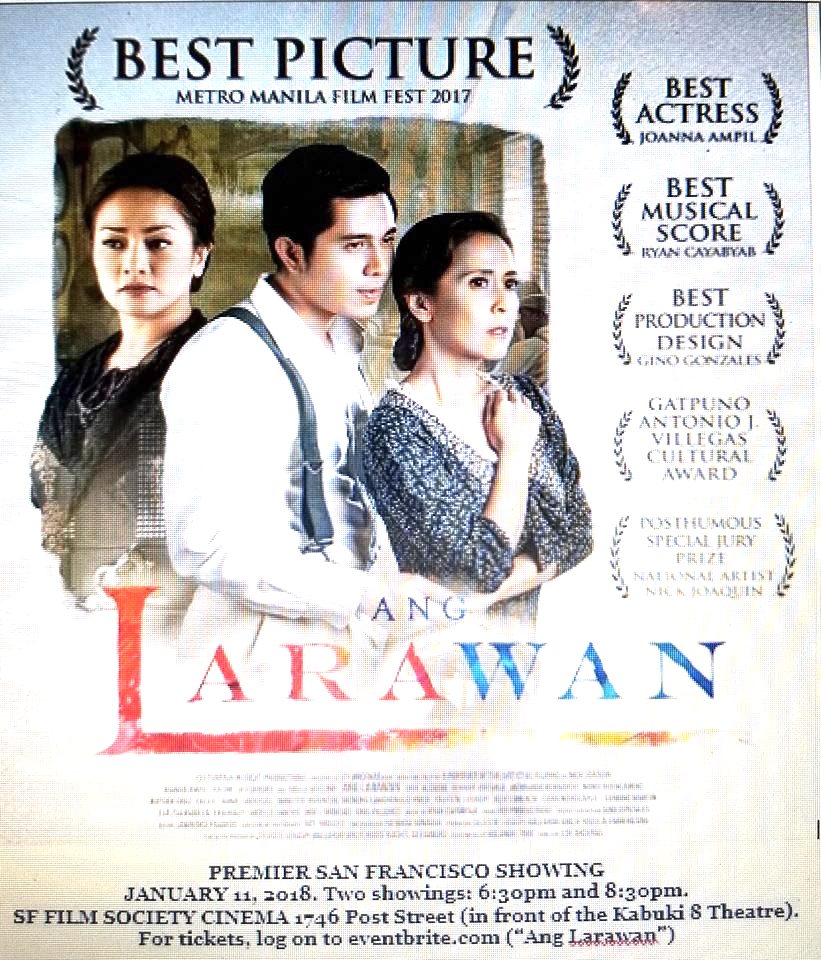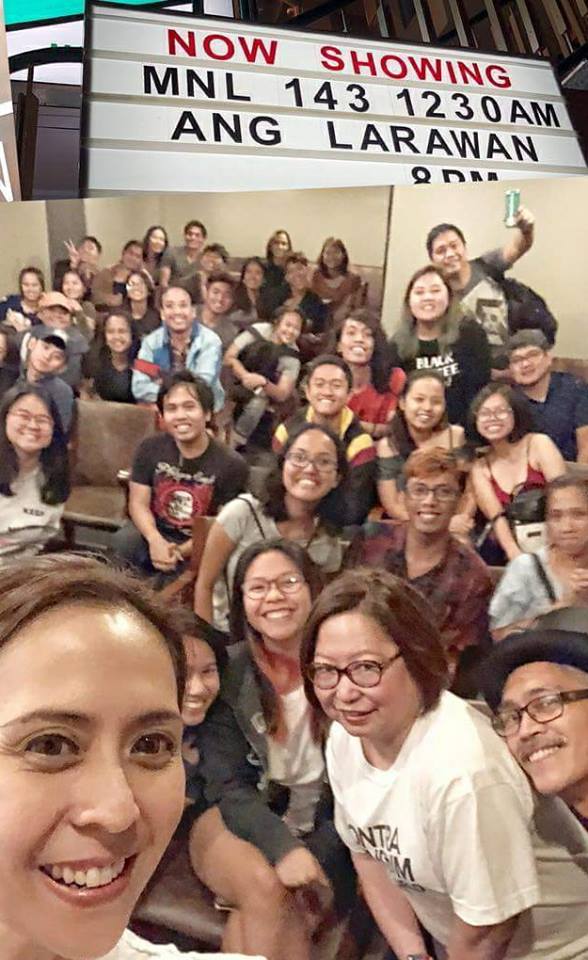We were so buzzed after watching the San Francisco premiere of “Ang Larawan” at the New People Cinema on January 11 that we gathered in the theatre lobby to share our thoughts and feelings about what we had just seen.
Our neighbor, Julie Marsh, who had never seen a Philippine movie before, gushed about how it reminded her of the plays of Tennessee Williams (“The Glass Menagerie”, “Cat on a Hot Tin Roof”) where the central characters were also idealists fighting against a dying world. “Except in Tennessee Williams’ plays, they lose,” she added.
To opera buff Leon Palad, “Ang Larawan” was comparable in quality to the best of Giacomo Puccini (“Madama Butterfly”, “Tosca”, “Boheme”, “Turandot”) which were based on the concept of “verismo,” the realistic depictions of many facets of life.
Paul Drexler found the family conflict depicted in the Nick Joaquin play similar to those in the novels of Colombian writer Gabriel Garcia Marquez, winner of the 1982 Nobel Prize for Literature (“One Hundred Years of Solitude,” “Love in the Time of Cholera”).
Perhaps this movie will spark a campaign to nominate the late Nick Joaquin to be similarly honored with a Nobel Prize for Literature, which would be well-deserved and long overdue.
“We, as the audience, felt like we were with the characters in the musical, transported into another era,” observed Lorna Lardizabal Dietz. “We felt that the quality of the musical was comparable to ‘Les Miserables’ and ‘Phantom of the Opera.’”
Hollywood, take note
In her KQED Arts review of the film, Carol Escoda, noted that: “So far, Hollywood hasn’t figured out how to bring the movie musical into the 21st century. From the razzmatazz of ‘Moulin Rouge’ to the retro aspirations of ‘La La Land,’ filmmakers have shoehorned bankable stars into productions whose glitz cannot elevate formulaic story lines and uninspired scores. Maybe they should take a leaf from the distinguished team that has brought the classic Filipino play ‘Ang Larawan’ (‘The Portrait’) to the screen.”
In her review, which was handed out to the moviegoers after the screening, Escoda elaborated: “Translated into Tagalog, with a vibrant score that weaves opera, jazz and Broadway influences into the Filipino musical traditions of zarzuela and kundiman, the energy feels modern, even as the characters waft about in finely embroidered, Spanish Empire-cut gowns and clothes inspired by the flapper era. Both the Tagalog libretto, by poet and dramatist Rolando Tinio, and English subtitles powerfully and vividly distill the original English dialogue, particularly in scenes of highly charged confrontation.”
One young moviegoer, Julius Fernandez, said he wasn’t surprised at the film’s success. “When you combine all the greats of Philippine culture, Nick Joaquin, Rolando Tinio, Ryan Cayabyab, Loy Arcenas, and you add the performances of Joanna Ampil and Rachel Alejandro and the rest of the superb supporting cast and crew, how could it not be a success?”
Girlie connected the dots
I joined the discussion and added one more person to the mix — my sister, Girlie, who connected all the great dots.
Girlie was the only one of my siblings who chose to remain in the Philippines where she worked as a talent manager. In 1980, she produced the first concert of Kuh Ledesma with then nine-year-old Lea Salonga, as a surprise guest. They were among her early talents, which would later include Celeste Legaspi, Rachel Alejandro, Geneva Cruz and Joanna Ampil. Veteran superstar Nora Aunor revealed to me, when I met her at a dinner in Daly City one night a few years ago, that she too was once managed by my sister.
Following the triumph of the EDSA People Power Revolution in February 1986, Girlie brought Celeste Legaspi and other entertainers to the US to perform in Filipino communities throughout the US to celebrate the return of democracy to the Philippines after 14 years of the Marcos dictatorship.
When they returned back to Manila, Girlie and Celeste founded Musical Theatre Philippines (Musicat Productions) to develop and produce musicals that would showcase top-flight native talents: “Katy!” (1988), “Kenkoy Loves Rosing” (1992), “Alikabok” (1995), “Sino Ka Ba, Jose Rizal?” (1996), “Larawan, The Musical” (1997), “Fire Water Woman” (1999), and “Saranggola ni Pepe” (2008).
Inquirer Theater editor Gibbs Cadiz described Musicat as “the only local theater company exclusively dedicated to commissioning and mounting original Filipino musicals.”
“Ang Larawan” was easily Girlie’s favorite. She recalled the time when she discussed with Celeste the possibility of transforming Nick Joaquin’s English language classic play “Portrait of the Artist as Filipino” into a Tagalog musical, they were excited about introducing Nick Joaquin to future generations of Filipinos, for them to love Philippine literature.
Introducing Nick Joaquin to future generations
Sometime in 1996, they discussed their proposed project with Nick Joaquin and after several Wednesday lunches; he was on board and excited about the prospect of a musical version of his play and in Tagalog.
As payment for the stage rights to his play, Nick Joaquin asked simply for a typewriter similar to the one he used in the past. Girlie found one. He also asked one more thing. He wanted no one but the great Rolando Tinio to write the Tagalog libretto, a condition that Celeste and Girlie happily obliged.
Rolando Tinio, National Artist for Theatre Arts, accepted the challenge and delivered the libretto in just three weeks. To put music to Tinio’s lyrics, they approached their friend, Ryan Cayabyab, and, busy as he was, he too was all in.
Ryan asked Girlie and Celeste to hire some actors to read the libretto out loud as he recorded them and from there he wrote the inspired music that may well be his greatest legacy.
For the starring roles, Celeste Legaspi would play Candida and Zsazsa Padilla would take on the role of Paula with movie actor Ricky Davao as the rakish Tony Javier. It was a three-hour musical that was performed in the main theatre of the Cultural Center of the Philippines (CCP). Rolando Tinio directed it but died just before the musical opened in 1997.
It was such a smashing success that the public clamored for its return a year later. Unfortunately, Zsazsa could not reprise her role because of the deteriorating health of her husband, Dolphy. So Rachel Alejandro had to pinch hit for Zsazsa as she knew the songs and could sing them as well as anyone.
Girlie recalled the time in 1998 when Nick Joaquin attended a rehearsal and complained that Rachel was too young to play Paula. Girlie explained that they could find no one else to sing the songs of Paula the way Rachel could.
When Girlie visited me in San Francisco after the successful 1998 stage performance of “Ang Larawan,” she inquired if I could sponsor its live performance in San Francisco. I checked with the local theatres and concluded that it just was not financially viable to transport the whole troupe to San Francisco for a live performance.
From stage musical to the silver screen
It would be more practical to make “Ang Larawan” into a film so it can be shown in San Francisco and all over the U.S., I suggested.
As it turned out, Rachel and Girlie also had the same thought, but raising the money to produce the film was going to be a daunting task.
About 10 years later, when Girlie became the manager of Joanna Ampil in 2008, she immediately saw her as the Candida of “Ang Larawan” and discussed the role with her. Joanna had played the lead role of Kim in the London West End production of “Miss Saigon” but Candida would pose a formidable challenge to her. She was comforted by the fact that she would be paired with Rachel Alejandro reprising her role as Paula at the right age to satisfy Nick Joaquin.
The casting was nearly set. All that was left was the most critical for the film, the director. Starting in 2012, Girlie began interviewing a number of directors for the film. Unfortunately, she couldn’t find one with the right vision and the willingness to commit time for the project.
In 2014, Girlie was introduced by her friend, Gino Gonzales, to veteran Broadway stage manager and director Loy Arcenas and they discussed the film project. Girlie was impressed with Loy’s vision of how the play could work as a film. Their discussions convinced Girlie that Loy was the final piece of the puzzle. Her Musicat partners, Rachel and Celeste, agreed.
Despite the absence of funds, “Ang Larawan” began rehearsals in 2014. Before actual filming began, “Direk” Loy Arcenas required a full year of rehearsals, which were held at the Regal Films studio provided for free by its owner, Mother Lily Monteverde.
A full year of rehearsals
Menchu Lauchengco-Yulo, who played Pepang in the film, recalled the filming experience as “the most wonderful and amazing process.”
“We had a year practically of rehearsing it. We knew the movie inside out,” she said. “We were blocked, we staged it, we had run-throughs, so when we got to the actual filming, it was a breeze because we knew exactly what we were doing, everything memorized. We knew exactly what the objectives were. It was just a matter of positioning, where to go, what to do, but the subtext, the objectives, everything was already there. So it was wonderful. And the entire cast was so supportive and helpful.”
During that year of rehearsals, Girlie had the responsibility of raising the 25 million pesos that was budgeted for the movie. The big movie studios wouldn’t touch the project because there were no established movie stars in it and the setting was in the 1930s, too old-fashioned, they said. “The millennials will never go for this,” she was warned.
So Girlie had to raise the money, one million pesos at a time. When she asked friends and relatives to invest in the film, one of the first to come forward was our sister, Loida, and her husband, Jon Abraham. Another was Rachel’s husband, Carlos Santamaria.
When Girlie met with our brother, Gevic, who was visiting in Manila, he introduced her to his doctor friend, who was the brother-in-law of Jim Paredes. Girlie informed him about her film project and that she was raising funds for it. At the end of their conversation, he had only one question to ask her: “Can I still invest?” She answered yes and he did.
The money whisperer
Celeste was so impressed, she started calling Girlie the money whisperer. “Anyone who sits beside Girlie will be instantly convinced to invest in her project,” she said.
Girlie’s pitch was simple: “What do you do with your money? You buy a house, you buy a car, and many years from now, the car will be in a junkyard, the house may or may not still be there, but if you invest in the movie, your name will be on our movie credits forever.”
The film was completed in 2015, but it would take another two years of post-production to get the it ready for showing.
Ang Larawan was the last film selected for inclusion in the Metro Manila Film Festival (MMFF) which opened on Christmas Day of 2017. It was shown in 53 movie theatres throughout the Philippines. But two days after its showing, more than half of the theatres pulled the movie out because it wasn’t drawing the audience that was flocking to the action and slapstick comedy films that was the country’s staple.
When news of the pull out of “Ang Larawan’ from the movie theatres came out, the millennials rallied behind the film trending it on Twitter and Facebook. Young fans started flocking to the movie. “I’ve seen it three times and I’m going back to see it again,” one wrote.
After “Ang Larawan” won the Best Picture Award at the MMFF, movie theatres brought the movie back and it started showing in more than 60 theatres nationwide. The movie was also shown in the US for one week from January 12 to 18. Popular demand for the film has extended its run in a number of US theatres through January 26.
A beautifully crafted movie
San Francisco filmmaker Mona Lisa Yuchengco described “Ang Larawan” as a “beautifully crafted movie that portrays the conflict between Filipino identity and family, between artist and citizen. Rolando Tinio’s words, Ryan Cayabyab’s music and the genius of director Loy Arcenas make the movie a masterpiece that all Filipinos should be proud of.”
My favorite scene in the movie is when Don Perico, played brilliantly by veteran actor Robert Arevalo, rationalizes why he gave up his art, his poetry, and chose instead to pursue a political career that made him rich. “Life, like art, is intricate—charting paths carved by a force. We do not possess the future. We are but bystanders, making side bets. Propositioning Fate.”
Girlie and her co-producers, Celeste and Rachel, did not just proposition fate, they charted their own path and, judging from the critical acclaim and the box-office receipts, it seems clear that their film will possess the future.
In the end, it is not just Girlie’s ‘Larawan,’ nor Celeste’s, nor Rachel’s, nor Loy’s. It is the Filipino people’s “Larawan.”
(Send comments to Rodel50@gmail.com)







